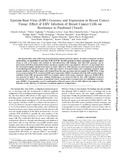Mostrar el registro sencillo del ítem
Epstein-Barr Virus (EBV) Genome and Expression in Breast Cancer Tissue: Effect of EBV Infection of Breast Cancer Cells on Resistance (Taxol)
| dc.creator | Arbach, Hratch | |
| dc.creator | Viglasky, Viktor | |
| dc.creator | Lefeu, Florence | |
| dc.creator | Guinebretière, Jean-Marc | |
| dc.creator | Ramírez Mayorga, Vanessa | |
| dc.creator | Bride, Nadège | |
| dc.creator | Boualaga, Nadia | |
| dc.creator | Bauchet, Thomas | |
| dc.creator | Peyrat, Jean-Philippe | |
| dc.creator | Mathieu, Marie-Christine | |
| dc.creator | Mourah, Samia | |
| dc.creator | Podgorniak, Marie-Pierre | |
| dc.creator | Seignerin, Jean-Marie | |
| dc.creator | Takada, Kenzo | |
| dc.creator | Joab, Irène | |
| dc.date.accessioned | 2015-04-17T20:35:14Z | |
| dc.date.available | 2015-04-17T20:35:14Z | |
| dc.date.issued | 2006-01 | |
| dc.identifier.citation | http://jvi.asm.org/content/80/2/845.full | |
| dc.identifier.issn | 1098-5514 | |
| dc.identifier.uri | https://hdl.handle.net/10669/11389 | |
| dc.description | Artículo científico -- Universidad de Costa Rica. Instituto de Investigaciones en Salud, 2006 | es_ES |
| dc.description.abstract | The Epstein-Barr virus (EBV) has been detected in subsets of breast cancers. In order to elaborate on these observations, we quantified by real-time PCR (Q-PCR) the EBV genome in biopsy specimens of breast cancer tissue as well as in tumor cells isolated by microdissection. Our findings show that EBV genomes can be detected by Q-PCR in about half of tumor specimens, usually in low copy numbers. However, we also found that the viral load is highly variable from tumor to tumor. Moreover, EBV genomes are heterogeneously distributed in morphologically identical tumor cells, with some clusters of isolated tumor cells containing relatively high genome numbers while other tumor cells isolated from the same specimen may be negative for EBV DNA. Using reverse transcription-PCR, we detected EBV gene transcripts: EBNA-1 in almost all of the EBV-positive tumors and RNA of the EBV oncoprotein LMP-1 in a smaller subset of the tissues analyzed. Moreover, BARF-1 RNA was detected in half of the cases studied. Furthermore, we observed that in vitro EBV infection of breast carcinoma cells confers resistance to paclitaxel (taxol) and provokes overexpression of a multidrug resistance gene (MDRI). Consequently, even if a small number of breast cancer cells are EBV infected, the impact of EBV infection on the efficiency of anticancer treatment might be of importance | es_ES |
| dc.description.sponsorship | info:eu-repo/grantAgreement/Universidad de Costa Rica/Instituto de Investigaciones en Salud//// | es_ES |
| dc.language.iso | en_US | es_ES |
| dc.publisher | Journal of Virologia 80(2) p 845-853. | es_ES |
| dc.source | Journal of Virology 80(2):845-853 | es_ES |
| dc.subject | Neoplasias de la Mama | es_ES |
| dc.subject | Reacción en Cadena de la Polimerasa | es_ES |
| dc.subject | Antígenos Nucleares del Virus de Epstein-Barr | es_ES |
| dc.subject | Antígenos Nucleares EBV | es_ES |
| dc.subject | Cáncer de seno | es_ES |
| dc.title | Epstein-Barr Virus (EBV) Genome and Expression in Breast Cancer Tissue: Effect of EBV Infection of Breast Cancer Cells on Resistance (Taxol) | es_ES |
| dc.type | artículo original | |
| dc.identifier.doi | 10.1128/JVI.80.2.845-853.2006 | |
| dc.description.procedence | UCR::Vicerrectoría de Investigación::Unidades de Investigación::Ciencias de la Salud::Instituto de Investigaciones en Salud (INISA) | es_ES |
Ficheros en el ítem
Este ítem aparece en la(s) siguiente(s) colección(ones)
-
Microbiología [1171]


